Blitzkrieg 1914. Samsonov's lost triumph
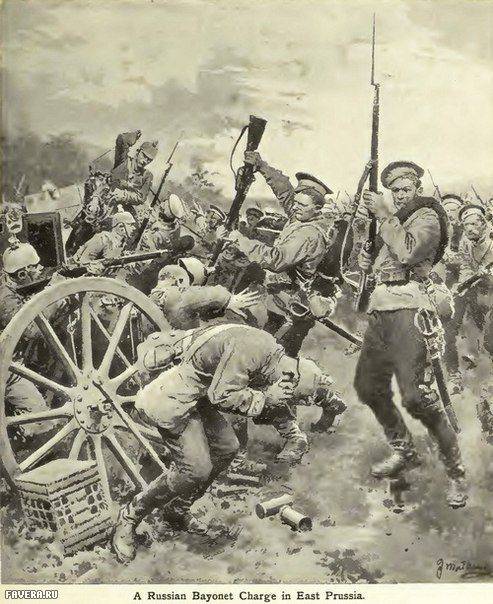
Chronicle of events
The East Prussian operation began on August 17 with a successful battle for the 8 German army at Stallupenen. And on the 20 of August, the Gumbinen-Goldap battle took place, which in our historiography is interpreted as victorious. Indeed, the German army suffered greater losses than the Russian, but if the 8 Army retreated, it was not at all because Pritvits considered himself defeated.
The Russian historian S. L. Nelipovich thus sums up the results of the Battle of Gumbinnen:
These circumstances made it possible for the German military council, assembled on the night of August 21, to speak out for resuming the attack from 3 hours.
However, a powerful radio station in Königsberg at night intercepted an order to the troops of the 2-th Russian army to cross the German border for operations in the rear of the Pritvice army. The headquarters of the 8 Army resolutely supported a retreat beyond the Vistula River, as was stipulated by the defensive action plan. The opinion of the corps commanders was not taken into account:
- ordered Pritvits.
The 1 Army Corps was ordered to go to Königsberg, and from there go by train to Graudenz, the 17 Army to leave via the Allenstein to the Wisla, the 3 Marine Division to Angerburg, the 1 Military Corps, the XNUMX Military Corps, Landwehr and cavalry - departure at the turn of the river Angerapp. This decision became fatal for M. Pritvice von Gafron. On the same night, the infantry general Francois complained to the Main Apartment that the army commander was leaving East Prussia to the Russians.
Pritvits, if you understand it well, did nothing wrong. According to pre-war plans, he attacked the weakest of the two Russian armies in the hope of victory. Victory did not work, and he ordered a departure for the Vistula. But according to Max Hoffman, even before he was removed from his post, the commander began to work out a plan for the transfer of all forces to the south, as Hindenburg subsequently did. The Hindenburg maneuver was not at all his personal ingenious find. The maneuver was worked out by the Germans at the command post exercises 1894, 1901, 1903, 1905. Naturally, in Russia they knew about its existence. But not all. The commander of the 15 AK Martos knew. Whether Zhilinsky and Samsonov knew is unknown. But Samsonov, just in case, kept 1 AK at Uzdau. Let me remind you that it was there that soon hit the 1 AK Francois.
Rennenkampf quite soberly assessed the result of the battle and at that moment he still did not consider himself a winner. Therefore, he stopped the troops to put in order for a day and naturally expected to continue.
Pritvits took advantage of this and came off. Numerous linear cavalry did not reveal a withdrawal, for they could not conduct deep reconnaissance, and Cossack units were not at hand of Khan Nakhichevan.
Not waiting for a new battle, Rennenkampf decided that the enemy turned out to be active and dug in on the Angerrap River. When he did not show up, and after a couple of days, Rennenkampf, together with Zhilinsky, finally became convinced of the retreat of the 8 Army. I think it is very likely that Russian intelligence learned about Pritvits’s order to withdraw and about the beginning of the movement of the corps. Probably the information came from the German General Staff. Hence the iron confidence of Zhilinsky who looked at the moment when the movement from the withdrawal turned into a maneuver. As a result, Rennenkampf received an order to besiege Königsberg, which he did.
Actions of the 2 Army
23 August. The 2 Army stumbled upon the German corps covering the northern direction of the 20. As a result, a series of battles took place in the Orlau area. The battle ended in a draw. Both sides suffered losses, but as a result of 37 the infantry division retreated in disarray. The result was the same as under Gumbinen: the enemy retreated, which testified to the local success of the North-Western Front, but on the whole it meant nothing.
24 August. 15 AK Martos continued the pursuit of the enemy. It is noteworthy that the 20 corps did not retreat to the north, as might be supposed, but to the west, substituting the right 1 fang for the corps of Artamonov, who still did not know that the 1 German corps Francois was moving towards him.
25 August. Following a two-day battle, Zhilinsky orders Samsonov to force the march and Samsonov fulfills the order. However, far-sightedly does not touch the 1 AK and even strengthens it with a division of 23 AK. As a result, the gap that arose between 1 and 15 AK at that time was not a serious threat.
Fulfilling the order of Zhilinsky, Rennenkampf and Samsonov give orders intercepted by the Germans.
After the battle at the front of the 15-th building 11 (24) Aug. the enemy retreated in the general direction on Osterode; The 1 Army continues to pursue the enemy, retreating to Koenigsberg and Rastenburg.
2-th Army - attack on the front of Allenstein, Osterode. 12 Aug Corps take lines:
13-mu - Gimendorf, Kurken; 15-mu - Nadrau, Paulsgut; 23-mu Mikhalken, Gross-Gardinen.
The stripes are delimited: 13 and 15 by the line Mushaken, Schwedrich, Visually; 15-th and 23-th line of Neidenburg, Vitigwalde, lake Shilling.
The 1 corps is to remain in the occupied area, providing the left flank of the army.
6 Corps - move to the Bishofsburg, Rotflis area to secure the right flank of the army from Rastenburg.
The 4 cd subordinate to the commander of the 6 corps is to remain Sensburg, scouting the strip between the lines of Rastenburg, Bartenstein and Sensburg, Heilsberg. 6-I and 15-I cd continue the task of the directive №4.
Ostroleka.
Samsonov.
Rennenkampf.
Now, knowing the exact location of 2A troops and knowing that 1A was far away, Hindenburg could confidently begin the operation.
The actual situation as of August 26 was as follows.
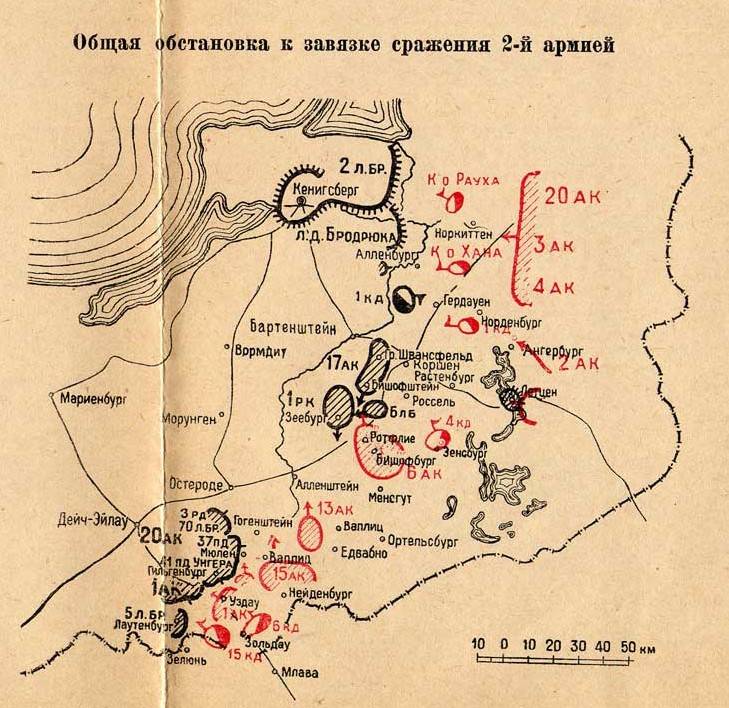
But from the point of view of Samsonov, everything looked different:
- There is no enemy in front of 6AK.
- There is no enemy in the north. The occupation of the 13-m Allenstein building blocks the path to the evacuation of the 6-th Landver Brigade from Letzen Fortress.
- The battered German 20 corps is deployed east-front. Before him also suffered the loss of 15 AK Martos, but also the fresh 2-th PD from 23 AK. And from its right flank is a fresh 1 AK Artamonov.
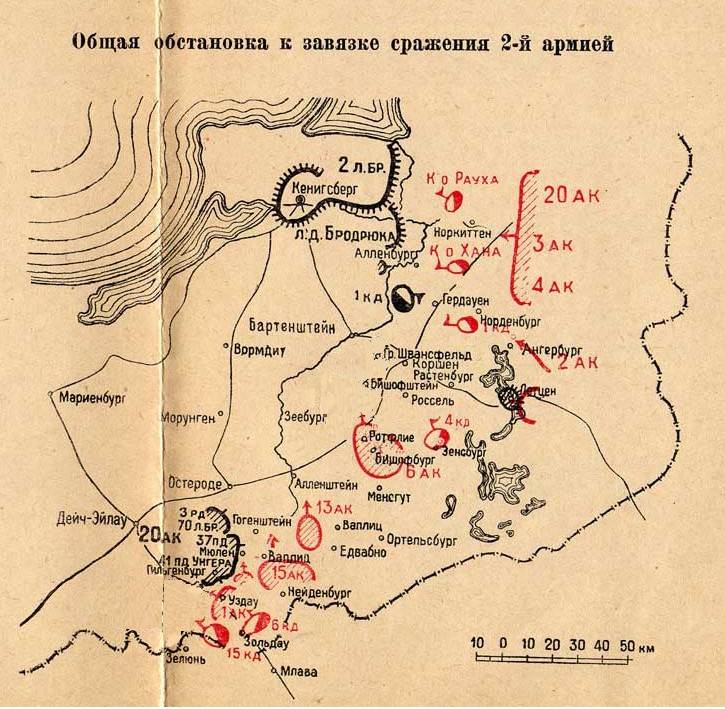
That is, the situation seems very promising.
Further events raced swiftly.
26 August. The 17th Mackensen Corps and the 1th Belov Reserve Corps with the Landver Brigade were moving towards Allenstein. The right-flank 6 corps advanced here. The German corps commander of the 4 infantry division was mistaken for fleeing from Rennenkampf and immediately attacked. As a result, a counter battle took place near the village of Gross-Bessau, during which the 6 AK lost more than 5 thousand people and left the cover, retreating. At the same time, General Blagoveshchensky threw troops and fled to the rear. But Samsonov did not receive information about this and on August 27 ordered the army to carry out the previously assigned task.
At the same time, Rennenkampf, fulfilling the order of Zilinsky, took Koenigsberg into the ring. The army cut the railway to Memel and reached the Baltic Sea. But the trains from the 1 AK have already proceeded south.
27 August. 1 AK Francois attacked 1 AK Artamonov, but was repelled. Among the Germans there was even a panic. Artamonov reported on success, but an hour later he ordered the retreat. However, Samsonov did not know about this either. On the other hand, François did not believe the Russians were leaving and ordered them to dig in quickly, waiting for a counterattack. He remained in place until the next day.
At the same time, 15 AK forces of one division pressed 20 AK and occupied Muhlen. The development of the offensive required reserves, but even this limited Russian success gave rise to doubts in Hindenburg about the possibility of encirclement.
Zilinsky is seeing and orders Rennenkampfu to move to join the 2 Army.
Samsonov, having received a message from Artamonov about repelling the attack, understood the situation and planned countermeasures. Since, as he believed, the two opposing first corps are holding each other back, he has a great opportunity to turn the 13 corps west with the 2,5 corps with a flank blow to defeat the 20 and then the 1 German corps.
In my opinion, a very real task. In order to organize a counterattack, the commander left for Nadrau that evening. There he ordered 1 AK to maintain positions north of Soldau, units of the 3 Guards and 2 Divisions at Frankenau. 6-th AK (not knowing that he had receded the day before) ordered to go to Passenheim. The 13 and 15 corps under the general command of Martos were given the task of advancing through Mühlen to Gilgenburg-Lautenburg with the aim of attacking the enemy. The corps was to go to the flank and rear of the German troops, who attacked the 2 division and the 1 corps. That is, success was planned at 28 number, designed to decide the fate of the entire battle in East Prussia.
28 August. The 13 AK advanced to join the 15, leaving a weak barrier in Allenstein. The reconnaissance discovered troops suitable from the east, but the corps commander considered this to be the Blagoveshchensky corps going to help and continued to move southwest.
Around 10 in the morning, Samsonov arrived at the headquarters of the 15 corps in Nadrau to coordinate the planned defeat of the 20 German corps. He did not receive Zhilinsky’s order of departure. By his arrival Martos defeated the 41-th German division at Vaplitz, taking 13 guns and more than a thousand prisoners. And then the information arrived about the 17 and 1-m reserve buildings heading to Allenstein.
By evening, Samsonov ordered the retreat.
29 August. 13, 15 and part of the 23 AK began to leave through the forest, full of ravines and lakes, which caused linear parts and carts to congregate on rare and narrow roads, interfering with each other. The German troops moving along the Neudenburg – Wallenberg road quickly cut off the retreat, and the 1 Reserve Corps hung on the shoulders of the 13 AK. The flank corps were removed by one and a half to two transitions, and the cavalry of the 1 Army at 80-100 km could not support the retreat.
30 August. 1 and 6 AK tried to help the encircled corps, but were repulsed.
On this battle ended. Part of the troops was able to break through those already such a dense ring of encirclement, but most were demoralized, ran out of ammunition and preferred to surrender. On the night of the 30, General Samsonov shot himself.
31 August. The cavalry of Khan Nakhichevan was already in Allenstein. Rennenkampf was late for one day. But this event completely erases all allegations of betrayal or criminal inaction of the commander of the 1 Army.
This is the end of the battle. Despite a series of defeats, in general, the Germans were able to win, and the capture of the two corps more than covered the losses they suffered.
Causes of defeat
Well-known reasons such as poor communication, poor intelligence, as a result of which erroneous decisions were made.
The 2 army corps seized from Samsonov did not participate in the battle of the 1 army or the 2 army, but stomped before Letzen. That is, it was just turned off. Remain in the 2A, and together with the 6 AK and 4 CD near Gross-Bessau, the troops could well repel the attacks of the 2,5 German corps, giving Samsonov time to solve problems on the left flank.
This is a key miscalculation of the command of the North-Western Front, to which I cannot find a clear explanation, nullified all the previous successes of both armies.
But even without 2 AK Samsonov had a chance.
If Zhilinsky, who was in victorious euphoria, came to his senses a day earlier, then the 13 AK would move not to Allenstein, but to Hohenstein. A much smaller force could cut the railway, for example, the 2 battalion as in real stories. In this case, a joint attack through Mühlen in the direction of Gilgenburg on 27 of August would have been more successful, would not have allowed Francois’s corps to pursue Artamonov’s corps and close the encirclement.
1 AK Artamonov should not have retreated. Artamonov, although he showed personal courage, but as a commander, the battle profiled. The Annunciation of 6 AK just scared, but in front of him, at least, was 2,5 corps. And in front of Artamonov alone, and that battered Rennenkampf. As a result, the decision on counterattack made by Samsonov should not be considered a mistake. He proceeded from incorrect data and still had a good chance of success.
When planning the retreat, Samsonov did not take into account that his troops would go through the forest, but Francois’s corps blocking him from the border along the road. That is, the Germans will always be ahead. This is Samsonov’s personal mistake. He had to either break through the 1 and 20 corps, connecting them with a fight, or take up a circular defense. But again, the decision was made without knowledge of the general strategic situation. There was no certainty that Khan's cavalry would succeed.
Thus, even in the conditions of Hindenburg's secretive maneuver, the situation could go according to three quite probable scenarios:
1. There is no mistake with the 2 AK, it covers the right flank along with the 6 AK. If the outcome of the battle was unfavorable, even retreating the corps would stop the threat of covering the right flank. In the center, the chances of our 2,5 corps against one battered 20 are greater than the chances of the Germans at Gross-Bessau. That is, 20 AK is guaranteed to leave the game and against Francois Samsonov would have had 1,5's against 4 corps, not counting the cavalry. And that would be a complete victory.
A second option to use the 2 AK would be his participation in the Battle of Gumbinnen. If he had been on the left flank of the 1-th army, and the fate of the German 1-th reserve corps would be sad. Even breaking away from the persecution, he would have been so weakened that the 6AK could have resisted, not allowing it to close the encirclement ring around the central corps of the 2 Army. Yes, and 2AK could well have time to help, for he would be the closest.
2. In the real history of the 2 AK, there is no second army on the right flank. But if Artamonov does not misinform Samsonov with a message about the success in repelling the attack of the Francois corps, then Samsonov takes the central corps back in advance, gathers him in a fist and, not allowing the environment, holds positions on the Uzdau - Ortelsburg line for 3 days. Really? I guess more than that. And on the 4 day, Rennenkampf appears on the horizon. That is, it was Artamonov who made a key oversight, predetermining the general failure of the army.
3. Samsonov does not retreat, and even, having on his shoulders the 1-th reserve corps, he consistently attacks the German 20-th and 1-th corps. Without a doubt, the losses will be huge, but no more than what happened in real history, given the captured. But after all, the losses of the Germans will be similar. Indeed, in the battles of East Prussia, the Germans and Russians suffered equal losses. Our 13 and 15 corps will prove to be ineffective, but the Germans will lose the 20 and 1. The environment will not happen, and within the 3 days Rennenkampf's cavalry appears in Allenstein. As a result, Hindenburg will simply have nothing to drive out Rennenkampf and he will have to retreat behind the Vistula.
The result of all the options is the capture of East Prussia and the siege of Koenigsberg.
And although the story went according to the fourth, the most unsuccessful scenario for us, the above considerations indicate that there was no foregone defeat. Moreover, Hindenburg initially had small chances and rightly feared an unfavorable outcome. Even Samsonov’s mistake caused the lack of reliable information at the time of the decision, and not at all the initially hopeless state of affairs.
The results of the consideration of the myth № 3
1. Rennenkampf's accusations of betrayal are a lie. He did everything he could, and he did not have enough days. Another day, and he would become a national hero.
2. Samsonov’s mistakes were caused by false information received from the front headquarters. He is blamed for the loss of army control due to a trip to Nadrau. But if he learned about the real state of affairs only on the 28 number, it does not matter from which place the order for retreat was given. This could not change anything. Unless I’d stay alive.
3. The forces of the 1 Army were quite enough to withstand the attacks of Pritz. 2 was strong enough to repel the attacks of Hindenburg. That is, the cause of the defeat is in a combination of circumstances, and not in principle impossibility.
That is, there was a chance to win the battle in East Prussia. Missed, yes. But he was.
But what would happen if we went the story according to any of the first three scenarios and justified our pre-war strategic plan?
This will already be a pure alternative, the purpose of which is to substantiate the assertion that the world could well do without a four-year massacre and little blood. True, it would be a completely different world.
Read about it in the 3 part.
To be continued ...
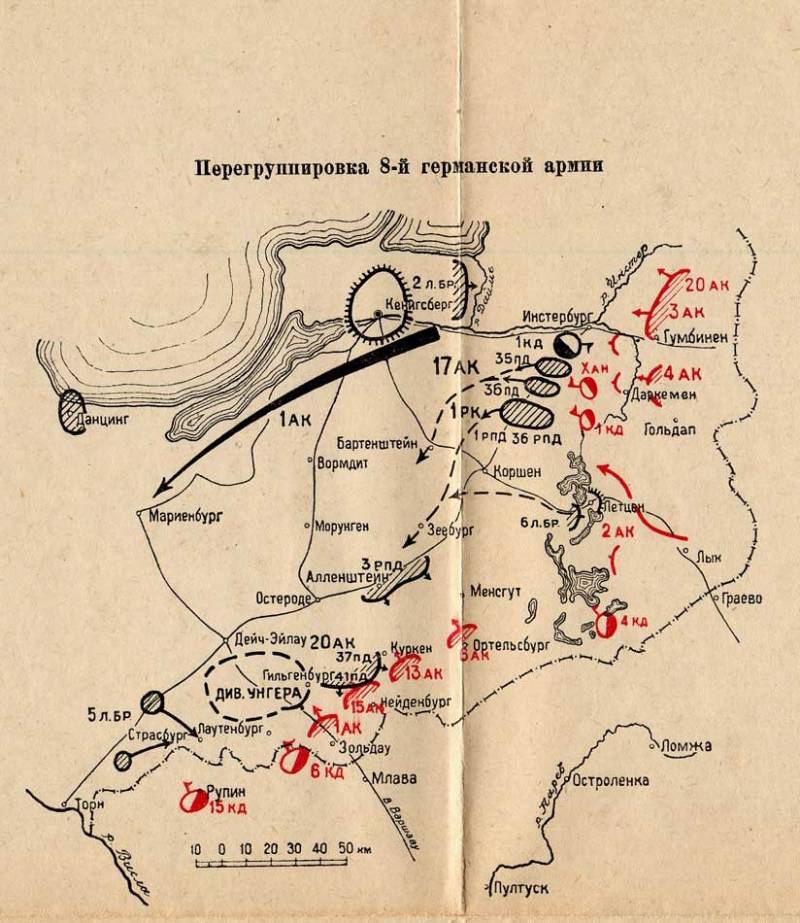
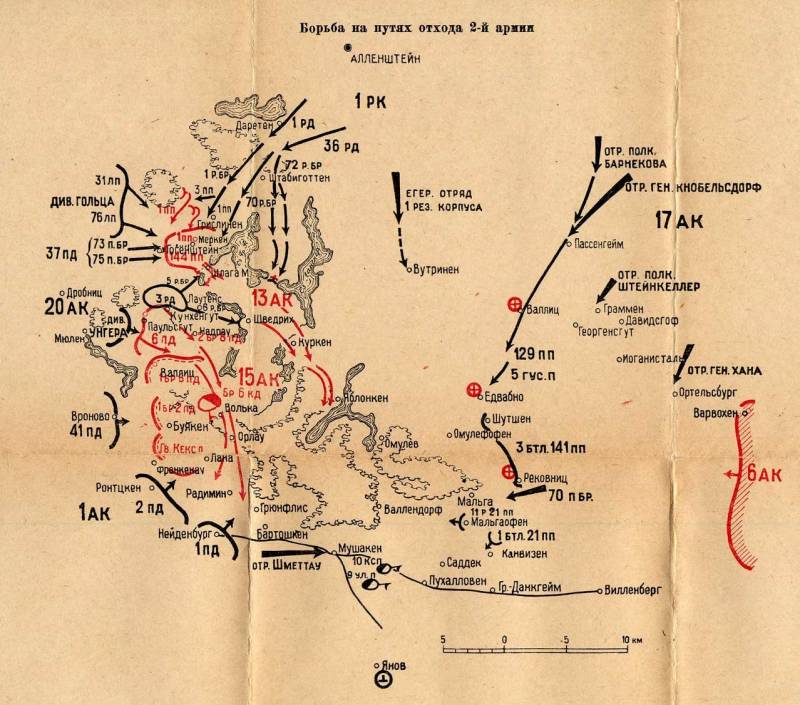
Information